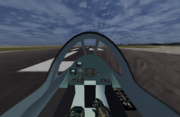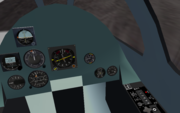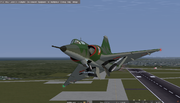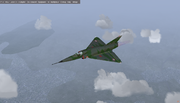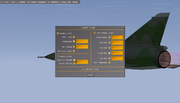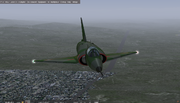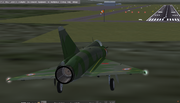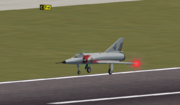Dassault Mirage III
The Dassault Mirage III is a fighter aircraft first developed in the late 1950s by Dassault Aviation of France. Initially developed from a smaller, less powerful prototype, it was then given a bigger wing, more power, and a stretched fuselage and put into production.
The Dassault Mirage III listed in the download section actually gives you two Mirage models, one is the Dassault Mirage V, the daytime interceptor model, and the Mirage IIING, which features a canard and ideally different handling characteristics, but in this file it seems to simply add the canard to the model and little else.
There is an alternative camouflage livery which is more like the Mirage we know so well, available under Liveries.
Flying The Mirage
Approach Speed set too low
Firstly it should be said that the stalling speed of the Mirage was set too low, as the 'approach speed' of the YASIM configuration file was set to 140 knots. The approach speed given in the Dassault company homepage is listed as 170 knots, and this is more realistic.
Take-off and landing
Take off is straight forward, and the aircraft lifts off well and climbs at a shallow angle. Speed builds up quickly, but turning tightly at low level is hazardous as the aircraft will hesitate in a turn and then drop a wing in the opposite direction, without enough altitude in may be difficult to recover from the incident. Otherwise flying is easy and stable, but as in the real thing, speed bleeds off with idle power and gear down so approaches have to be fast and flat. The landing is performed with the nose not high, I attempted to change the approach angle to 20 degrees instead of 6 degrees and this caused all sorts of errors on loading.
Instrumentation
Instrumentation is sparse, and oddly placed on a grey background that looks like it came from nowhere, I am in the process of changing this and improving the panel. The air speed indicator is a cryptically marked affair and the altimeter is dangerous to use. Using the head up display, especially one of the options using SHIFT+I will help fly the aircraft more accurately.
Autopilot
Setting the Autopilot to heading bug mode and setting the heading bug on the indicator worked well, but wings level mode rolled the aircraft uncontrollably. Setting vertical speed hold resulted in rapidly diverging oscillations.
Landing
Approach speed was at 200 knots, but if speed gets too low and power is increased, the aircraft will pick up so much speed that it will land at 200 knots which will probably burst the tires and run off the runway as well. One benefit of the Mirage is that there are no flaps to fail, so landing speed is always constant, depending on weight of course. The Mirage is loaded with fuel as default, reducing this to .40 fuel fraction ( meaning fraction of full capacity, not the fuel fraction in the engineering sense) helps lighten the aircraft but reducing below this fuel fraction results in the aircraft sitting on its tail.
Gallery
All except first, second and last screenshot taken using Flight Gear screenshot function
|
To do - Improvements
For myself or anyone improving this aircraft, here is a short to-do list
- Change interior panel to black
- Instrument panel should be more accurate in shape
- Add engine instruments - there are none
- Move instruments to positions that are more like actual panels
- Increase elevator movement (joystick settings)
- Add more instruments as panel is very sparse
- Add an optional panel with digital displays
- Improve pilot (!)
- Change angle of attack settings for a higher angle of attack when landing
- Adjust cockpit glazing (too reflective)
- Fix autopilot altitude modes
Reviewed Version:
MirageIII.zip 11.1 MB (11,101,929 bytes) http://mirrors.ibiblio.org/flightgear/ftp/Aircraft/
| |||||
